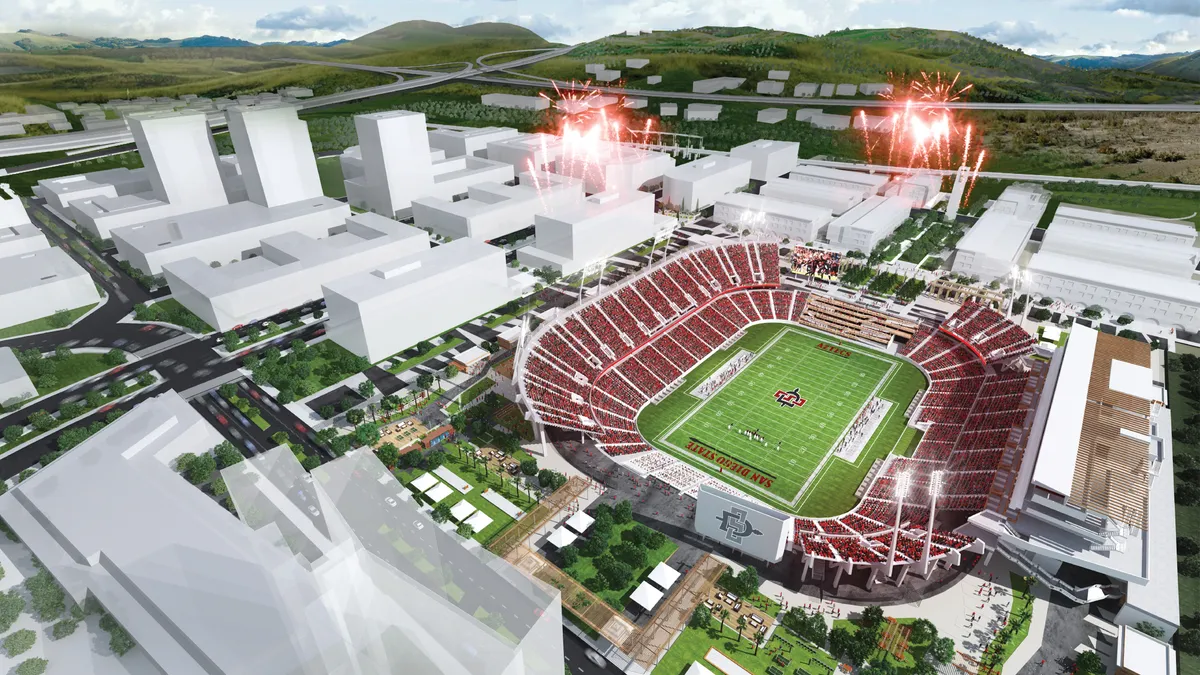Dive Brief:
- San Diego State University announced Thursday that it has chosen Clark Construction to design and build a new $250 million multi-use stadium at the school’s Mission Valley campus in San Diego.
- The 35,000-seat stadium will be able to expand to accommodate a variety of special events, as well as professional and collegiate sports. Construction, which will see workers paid a prevailing wage, is expected to begin early next year and wrap up in time for the 2022 National Collegiate Athletic Association (NCAA) season.
- Clark and SDSU will choose an architect together, and Clark will begin work on the design and planning while the university continues negotiations with the city of San Diego for the purchase of the property and develops the Draft Environmental Impact Report for the campus.
Dive Insight:
The stadium is among the first elements to be built at the Mission Valley site, along with a river park, the first housing units and innovation space. All in all, in addition to the new stadium, the campus will include a total of 1.6 million square feet of academic, research and innovation space; 89 acres of park and recreational areas; 4,600 residential units, a combination of student, faculty, staff, affordable, workforce and market-rate housing; 95,000 square feet of retail stores and other businesses that will serve both the campus and local neighborhood; hotel and conference facilities; and about 6,000 parking spaces.
The university estimates that it will have an initial $300 million outlay, financed through California State University revenue bonds and short-term financing, but intends to hand over a significant chunk of the project to the private sector via public-private partnerships. The CSU system, according to SDSU, has completed several P3s, including Innovation Village at California State Polytechnic University in Pomona and the University of California, Davis West Village.
The University of California Merced is currently in the midst of a $1.3 billion P3 project that will double the size of the campus and allow the university to serve the needs of the local community by increasing enrollment. When the university first announced the project in 2016, UC Merced Chancellor Dorothy Leland said the 39-year P3 agreement would do away with the deferred maintenance responsibilities that are a burden to so many other U.S. colleges and universities. UC Merced’s P3 partner Plenary Properties Merced will design, build and maintain the entire expansion as part of its agreement.
Deferred maintenance, as it pertains to universities and colleges, typically happens when there is not enough money in the budget to perform necessary repairs and upkeep. These tasks — and the price tag — accumulate as more and more items are delayed year after year.
In 2016, research group Sightlines projected that deferred maintenance needs among U.S. colleges and universities was about $30 billion, and more recent reports show they many of these institutions of higher learning are still struggling to keep their facilities in working order.
The University of Wisconsin system recently reported it has a $1.5 billion deferred maintenance backlog, while the Missouri Department of Higher Education is facing a similar price tag of $1.4 billion. In Illinois, the backlog is approaching $7 billion.












